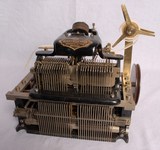Home: Miscellaneous
Please Note: Not all of the objects on this website are on display at the museum.

Larger image |
WIRELESS TELEGRAPHY LICENSE 1923, 1923 Paperwork relating to an application for a wireless license in 1923 under the Telegraphy Act of 1904 it was necessary to have a license to receive wireless messages by Telegraphy and a separate licence to transmit telegraphy messages. Francis Leslie Freeland was under 21 in April 1923 so his father had to apply on his behalf J.H.Freeland. The licence obtained was for the reception of telegraphy signals and also to experiment with equipment of his own. The Aerial had to be no more than 100 feet high and no more than 100 feet long; the use of a heterodyne oscillator directly connected to the aerial was not permissible between the hours of 9PM and 11PM weekdays and Sundays and not between the wavelengths of 300 to 500 metres. Also supplied at the time by the Controller and Accountant General Mr H.N. Bunbury of the General Post office was an application form for transmitting equipment. This does not appear to have been used. A1587 |

Larger image |
TELEGRAPH RELAY, 1899 Removed from the South Western House Hotel, built in 1830, by Peter Silett a radio engineer for Radio Solent. Identified as a telegraph relay, however the three contacts are too large for Telegraph Transmission, and it may have been used in a supervisory mode such as power control. Be the first to write a comment about this objectA1583 |

Larger image |
1965/6 TELEGRAMS, 1965 Two examples of machine printed tape on Telegrams. See Item A0098 in Sounders and Stations section. View 1 comment about this objectA0197 |

Larger image |
BRASS BASE SINGLE CORE CABLE, 1900's Single core Telegraphy cable with steel armour for under ground use. A0573 |

Larger image |
SINGLE CORE ARMORED CABLE, 1900's Early under ground or under water telegraphy cable. A0571 |

Larger image |
SAMPLE OF CABLE LAID BY GREAT EASTERN, 1865 The transatlantic telegraph cable was the first cable used for telegraph communications laid across the floor of the Atlantic Ocean. It crossed from the Telegraph Field, Foilhommerum Bay, Valentia Island, in western Ireland to Heart's Content in eastern Newfoundland. A1317 |

Larger image |
CENTRE SECTION OF 1st TRANSATLANTIC CABLE, 1860's The transatlantic telegraph cable was the first cable used for telegraph communications laid across the floor of the Atlantic Ocean. It crossed from the Telegraph Field, Foilhommerum Bay, Valentia Island, in western Ireland to Heart's Content in eastern Newfoundland. A1316 |

Larger image |
COHERER DEMONSTRATION BOARD, 1920's The first radio transmissions were made using a spark transmitter and a receiver known as a 'Coherer'. A1284 |

Larger image |
COMMUTATOR KEY, 1930's Polarity reversing key known as a "Commutator Key". A0237 |

Larger image |
TRANSATLANTIC CABLE IN PENDANT AND LETTER, 1866 Detail of Letter A0567 |

Larger image |
SINGLE CORE POST OFFICE TELEGRAPHY CABLE, 1900's Early armour protected cable for under ground use. Insulation may be Gutta Percha. Gutta percha was obtained from a variety of guttiferous trees throughout the Pacific Rim although different varieties produce materials of differing quality. The differences generally reflect the quantity of resin in the product with that from Pahang having the lowest resin content. Balata has one of the highest resin contents and was obtained from trees in the tropical regions of South America. A0572 |

Larger image |
4 CORE ARMORED TELEGRAPHY CABLE, 1900's Telegraphy cable heavily armoured and further protected with layers of hemp saturated in a water proof compound, for under sea use. It is possible of course that this could have been used for Telephony. Be the first to write a comment about this objectA0576 |

Larger image |
SINGLE CORE TELEGRAPHY CABLE, 1930's Early Telephone or Telegraphy cable possibly for under sea use. A0570 |

Larger image |
4 POLE SWITCH WITH PEGS, 1920's Early method of switching circuits using removable pegs. A0805 |

Larger image |
4 WAY SWITCH WITH CRANK, 1930's School Laboratory Switch supplied by Griffin & George for Universities and Colleges. Be the first to write a comment about this objectA0806 |
Further Reading (external sites):
Back to top









